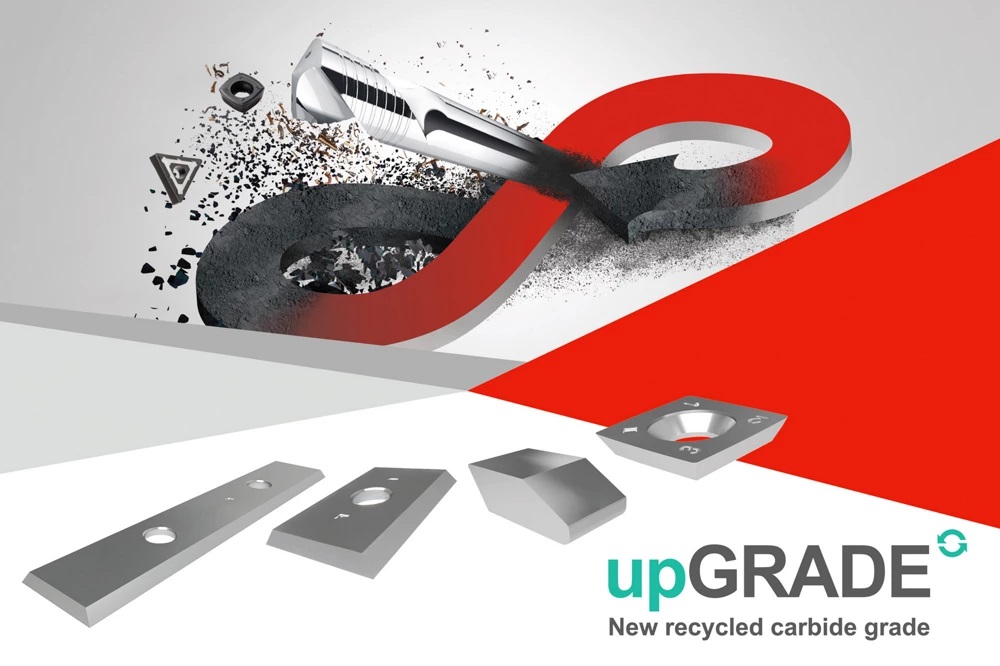
Ceratizit has received an environmental award known as the Prix de l'Environnement 2023 from the Luxembourg industry association FEDIL for the process used to manufacture the carbide grades in the upGRADE family of cutting tools.
The company said that by using secondary raw materials from an optimized recycling process, the carbide grades have a low carbon footprint, and achieve the high performance of a premium carbide grade.
“Mining ore containing tungsten already pays off starting at a content of 0.06%. This means that around 200 tons of ore have to be transported to obtain one ton of metallic tungsten, which requires a lot of energy,” said Dr Ralph Useldinger, head of group analytics and fundamental R&D. “This is why Ceratizit only uses secondary raw materials from the zinc recycling process for the upGRADE grades to minimize the carbon footprint of the products.”

Low CO2 emissions
The zinc used to break up the carbide structures is reused, meaning that the process produces emissions almost exclusively as a result of the necessary electricity. However, Ceratizit can also score points in this area: "Since the beginning of 2023, we have only been purchasing green electricity from sustainable sources,” said Frank Thomé, executive board member.
Thomé also said the tooling line’s varieties play an important strategic role. “The upGRADE product family is an important component of our sustainability strategy. They prove that more sustainable carbide products are possible without having to compromise on performance.”
Useldinger said that the company uses high-quality, meticulously sorted carbide scrap in the recycling process. “In zinc recycling,” he said, “the structure of the tungsten carbide remains unchanged. This means that the quality I put in is the quality I get out.”
Two carbide grades
The upGRADE product family currently features two carbide grades. CT-GS20Y for metalworking, which has already won the Best of Industry Award, and KLC20+ for knives, rods, and saw teeth for woodworking, which was presented at LIGNA in May.
They form the vanguard of a product portfolio that, according to Thomé, is set to become increasingly sustainable in the coming years: “Our goal is to be the leader in sustainability in the cemented carbide and cutting tool industry by 2025. That's why we are not only actively working to further reduce our corporate carbon footprint, but are also gradually adding more products with a particularly low product carbon footprint to our product portfolio.”
Contact Details
Related Glossary Terms
- metalworking
metalworking
Any manufacturing process in which metal is processed or machined such that the workpiece is given a new shape. Broadly defined, the term includes processes such as design and layout, heat-treating, material handling and inspection.
- sawing machine ( saw)
sawing machine ( saw)
Machine designed to use a serrated-tooth blade to cut metal or other material. Comes in a wide variety of styles but takes one of four basic forms: hacksaw (a simple, rugged machine that uses a reciprocating motion to part metal or other material); cold or circular saw (powers a circular blade that cuts structural materials); bandsaw (runs an endless band; the two basic types are cutoff and contour band machines, which cut intricate contours and shapes); and abrasive cutoff saw (similar in appearance to the cold saw, but uses an abrasive disc that rotates at high speeds rather than a blade with serrated teeth).
- tungsten carbide ( WC)
tungsten carbide ( WC)
Intermetallic compound consisting of equal parts, by atomic weight, of tungsten and carbon. Sometimes tungsten carbide is used in reference to the cemented tungsten carbide material with cobalt added and/or with titanium carbide or tantalum carbide added. Thus, the tungsten carbide may be used to refer to pure tungsten carbide as well as co-bonded tungsten carbide, which may or may not contain added titanium carbide and/or tantalum carbide.

